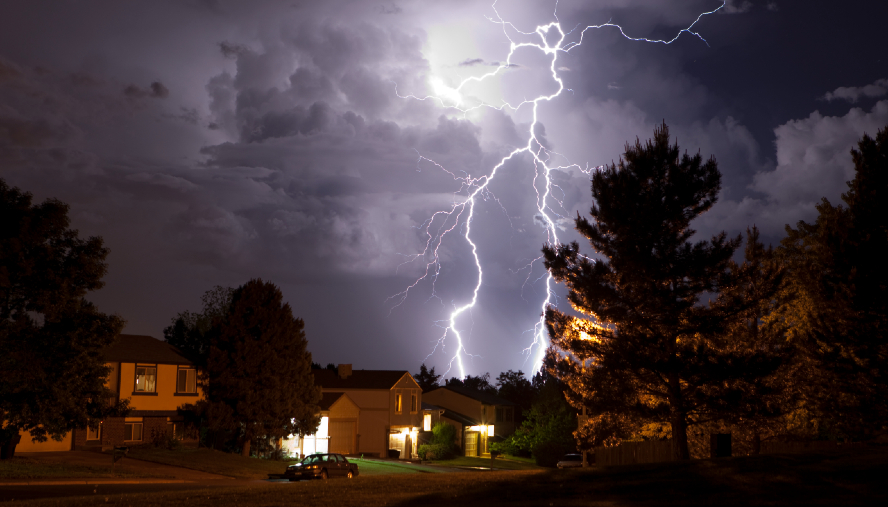How Thunderstorms Cause a Surge of Asthma Symptoms
The idea that thunderstorms can aggravate asthma symptoms seems counterintuitive. After all, light rains tend to decrease the levels of airborne pollen, putting a damper on a known asthma trigger. However, according to Laurie Manka, MD, the elements of a heavy weather front can combine to create the perfect storm for asthma symptoms.

What Is Thunderstorm Asthma?
“There are three main stages,” said Dr. Manka. “First, the wind blows and concentrates pollens and mold spores, sweeping them up into the clouds. Second, humidity and electricity rupture the pollens and molds, creating particles that are smaller and easier to inhale into the lungs and sinuses. Third, gusts of wind disperse those small particles. And these can potentially affect a lot of people.”
The result is “thunderstorm asthma,” a phenomenon where symptoms like coughing and shortness of breath coincide with severe weather.
Spring and Summer Air
During the spring and summer, thunderstorms are more prevalent and more asthma triggers are circulating. Pollen and mold spore counts are higher throughout these seasons, and they’re not alone. Particles from air pollution and wildfire smoke come into play, as well as rising temperatures.
These substances also can be whipped up by thunderstorms, leading to a cocktail of asthma triggering particles. Because winds can carry these particles over great distances, you don’t have to be near the source of an asthma trigger for it to affect you. “During a thunderstorm, pollens can be spread for miles,” explained Dr. Manka.
Have you been feeling okay? I’ve been feeling really good. Good!
What Bernice Roybal thought were recurring sinus infections turned out to be severe asthma. I was so weak I couldn't get out of bed. It was it was that bad. Take some nice big deep breaths…
Diagnosed as an adult, Bernice began working with Dr. Laurie Manka at National Jewish Health to track her symptoms and discover her asthma triggers.
Unexpected yet dangerous summer irritants are something Dr. Manka discusses with her patients.
For example, while rain can wash away some asthma irritants, thunderstorm asthma can occur as summer storms roll in and concentrate allergens and mold in the air.
Humidity and electricity rupture the pollens and the molds, making it making them smaller in size and more easily inhaled into the lungs and the sinuses.
Mold, grass, pollen and smoke from cookouts fireworks and wildfires all increase during the summer months, and climate change is expected to worsen these irritants over time.
We can expect worse pollen seasons due to the increased temperature and worse air pollution with higher levels of ozone and more drought cycles leading to forest fires.
Experts say knowing how your asthma reacts through the seasons and having a plan to adjust to these triggers can help prevent severe asthma episodes.
For Bernice, it's taking extra care during wildfire season. I can go on hikes. I can do almost anything.
At National Jewish Health, this is Barb Consiglio reporting.
How Do You Know if Thunderstorm Asthma Affects You?
Because asthma symptoms come and go, it can sometimes be difficult to determine specific triggers. According to Dr. Manka, people should work with their doctors to track down what’s making their symptoms worse. By narrowing down events that repeatedly aggravate their symptoms, patients can get a better handle on managing their asthma.
“We follow patients’ symptoms,” said Dr. Manka. “Some patients reliably have a worsening of their asthma in certain times of the year related to pollens. We can test for allergies to confirm or corroborate that. We also use lung function testing to monitor what their lung function is like when exposed to different things.”
For instance, without working with their doctors, many people with asthma might be unaware of how thunderstorms could exacerbate their condition. This is one of the many reasons why developing a strategy for managing asthma is so crucial.
How To Shelter Yourself From Asthma Storms
According to Dr. Manka, the best way to prepare for thunderstorm asthma is by working with your doctor to understand your triggers and using inhaled medications properly. Maintaining a healthy weight and adopting a healthy diet also can make a big difference.
“In people who have better controlled asthma, the likelihood of becoming severely ill from these particles goes down,” explained Dr. Manka. “That’s why it’s so important to track how these irritants affect your asthma, avoid exposure and have a solid plan with your doctor. So when you do encounter these triggers, they’re less likely to cause a serious problem that can lead to hospitalization.”
If you or anyone you know experiences asthma, a National Jewish Health allergist or pulmonologist can help. Learn more about our pediatric and adult asthma programs or make an appointment today.
